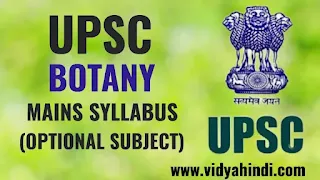Civil Services Botany Mains Syllabus (Optional Subject)
PAPER-I
1. Microbiology and Plant Pathology:
Structure and reproduction/multiplication of viruses, viroids, bacteria, fungi and mycoplasma; Applications of microbiology in agriculture, industry, medicine and in control of soil and water pollution; Prion and Prion hypothesis.
Important crop diseases caused by viruses, bacteria, mycoplasma, fungi and nematodes; Modes of infection and dissemination; Molecular basis of infection and disease resistance/defence; Physiology of parasitism and control measures; Fungal toxins; Modelling and disease forecasting; Plant quarantine.
2. Cryptogams:
Algae, fungi, lichens, bryophytes, pteridophytes-structure and reproduction from evolutionary viewpoint; Distribution of Cryptogams in India and their ecological and economic importance.
3. Phanerogams:
Gymnosperms: Concept of Progymnosperms; Classification and distribution of gymnosperms; Salient features of Cycadales, Ginkgoales, Coniferales and Gnetales, their structure and reproduction; General account of Cycadofilicales, Bennettitales and Cordaitales; Geological time scale; Type of fossils and their study techniques.
Angiosperms: Systematics, anatomy, embryology, palynology and phylogeny.
Taxonomic hierarchy; International Code of Botanical Nomenclature; Numerical taxonomy and chemotaxonomy; Evidence from anatomy, embryology and palynology.
Origin and evolution of angiosperms; Comparative account of various systems of classification of angiosperms; Study of angiospermic families?Mangnoliaceae, Ranunculaceae, Brassicaceae, Rosaceae, Fabaceae, Euphorbiaceae, Malvaceae, Dipterocarpaceae, Apiaceae, Asclepiadaceae, Verbenaceae, Solanaceae, Rubiaceae, Cucurbitaceae, Asteraceae, Poaceae, Arecaceae, Liliaceae, Musaceae and Orchidaceae.
Stomata and their types; Glandular and non-glandular trichomes; Unusual secondary growth; Anatomy of C3 and C4 plants; Xylem and phloem differentiation; Wood anatomy.
Development of male and female gametophytes, pollination, fertilization; Endosperm - its development and function; Patterns of embryo development; Polyembroyony and apomixes; Applications of palynology; Experimental embryology including pollen storage and test-tube fertilization.
4. Plant Resource Development:
Domestication and introduction of plants; Origin of cultivated plants; Vavilov's centres of origin; Plants as sources for food, fodder, fibre, spices, beverages,edible oils, drugs, narcotics, insecticides, timber, gums, resins and dyes, latex, cellulose, starch and its products; Perfumery; Importance of Ethnobotany in Indian context; Energy plantations; Botanical Gardens and Herbaria.
5. Morphogenesis:
Totipotency, polarity, symmetry and dfferentiation; Cell, tissue, organ and protoplast culture; Somatic hybrids and Cybrids; Micropropagation; Somaclonal variation and its applications; Pollen haploids, embryo rescue methods and their applications.
PAPER-II
1. Cell Biology:
Techniques of cell biology; Prokaryotic and eukaryotic cells-structural and ultrastructural details; Structure and function of extracellular matrix (cell wall), membranes-cell adhesion, membrane transport and vesicular transport; Structure and function of cell organelles (chloroplasts, mitochondria, ER, dictyosomes ribosomes, endosomes, lysosomes, peroxisomes); Cytoskelaton and microtubules; Nucleus, nucleolus, nuclear pore complex; Chromatin and nucleosome; Cell signalling and cell receptors; Signal transduction; Mitosis and meiosis; Molecular basis of cell cycle; Numerical and structural variations in chromosomes and their significance; Chromatin organization and packaging of genome; Polytene chromosomes; B-chromosomes' structure, behaviour and significance.
2. Genetics, Molecular Biology and Evolution:
Development of genetics; Gene versus allele concepts (Pseudoalleles); Quantitative genetics and multiple factors; Incomplete dominance, polygenic inheritance, multiple alleles; Linkage and crossing over; Methods of gene mapping, including molecular maps (idea of mapping function); Sex chromosomes and sex-linked inheritance, sex determination and molecular basis of sex differentiation; Mutations (biochemical and molecular basis); Cytoplasmic inheritance and cytoplasmic genes (including genetics of male sterility).
Structure and synthesis of nucleic acids and proteins;Genetic code and regulation of gene expression; Gene silencing; Multigene families; Organic evolution?evidences, mechanism and theories.
Role of RNA in origin and evolution.
3. Plant Breeding, Biotechnology and Biostatistics:
Methods of plant breeding?introduction, selection and hybridization (pedigree, backcross, mass selection, bulk method); Mutation, polyploidy, male sterility and heterosis breeding; Use of apomixes in plant breeding; DNA sequencing; Genetic engineering ? methods of transfer of genes; Transgenic crops and biosafety aspects; Development and use of molecular markers in plant breeding; Tools and techniques - probe, southern blotting, DNA fingerprinting, PCR and FISH. Standard deviation and coefficient of variation (CV); Tests of significance (Z-test, t-test and chi-square test); Probability and distributions (normal, binomial and Poisson); Correlation and regression.
4. Physiology and Biochemistry:
Water relations, mineral nutrition and ion transport, mineral deficiencies; Photosynthesis?photochemical reactions; photophosphorylation and carbon fixation pathways; C3, C4 and CAM pathways; Mechanism of phloem transport; Respiration (anerobic and aerobic, including fermentation)?electron transport chain and oxidative phosphorylation; Photorespiration; Chemiosmotic theory and ATP synthesis; Lipid metabolism; Nitrogen fixation and nitrogen metabolism; Enzymes, coenzymes; Energy transfer and energy conservation; Importance of secondary metabolites; Pigments as photoreceptors (plastidial pigments and phytochrome); Plant movements; Photoperiodism and flowering, vernalization, senescence; Growth substances?their chemical nature, role and applications in agri-horticulture; Growth indices, growth movements; Stress physiology (heat, water, salinity, metal); Fruit and seed physiology; Dormancy, storage and germination of seed; Fruit ripening?its molecular basis and manipulation.
5. Ecology and Plant Geography:
Concept of ecosystem; Ecological factors; Concepts and dynamics of community; Plant succession; Concept of biosphere; Ecosystems; Conservation; Pollution and its control (including phytoremediation); Plant indicators; Environment (Protection) Act.
Forest types of India-Ecological and economic importance of forests, afforestation, deforestation and social forestry; Endangered plants, endemism, IUCN categories, Red Data Books; Biodiversity and its conservation; Protected Area Network; Convention on Biological Diversity; Farmers? Rights and Intellectual Property Rights; Concept of Sustainable Development Biogeochemical cycles; Global warming and climatic change; Invasive species; Environmental Impact Assessment; Phytogeographical regions of India.


कृपया कमेंट बॉक्स में कोई भी स्पैम लिंक न डालें।